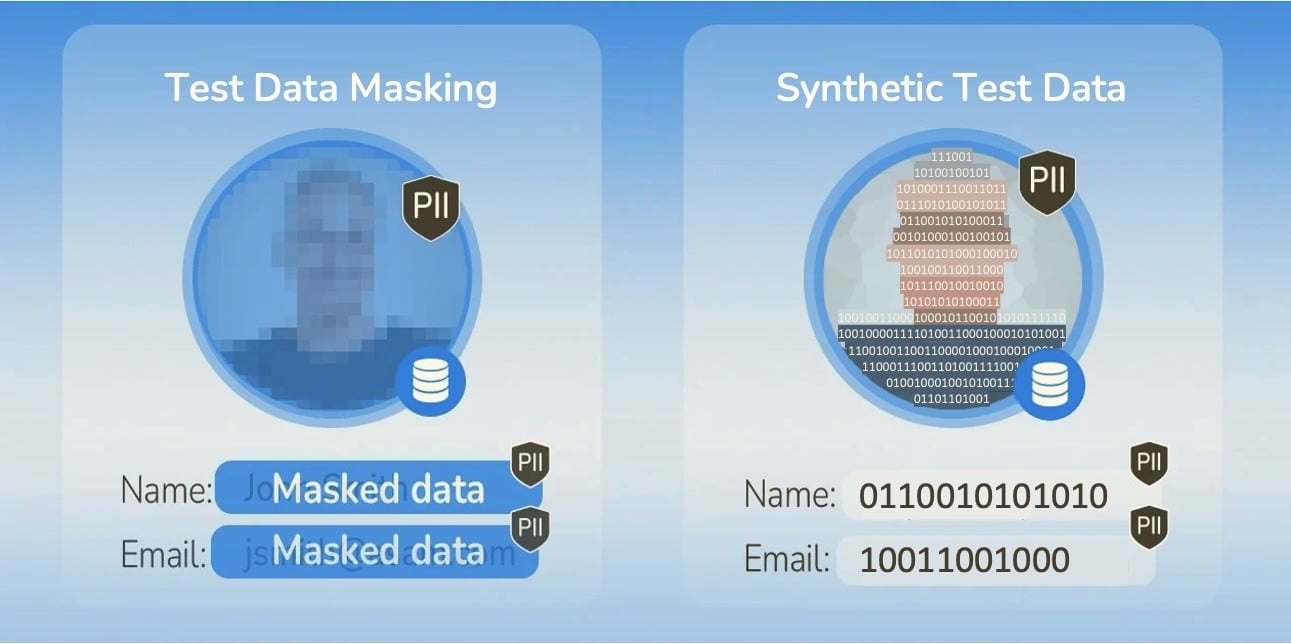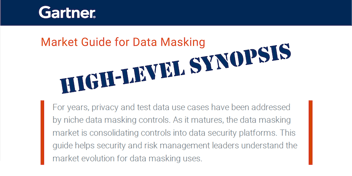To support continuous development, most enterprises rely on test data masking. But more and more are realizing the value in synthetic test data. Learn why.
How is Synthetic Test Data Used in Test Data Management?
As data regulations expand, software development and data privacy have become inextricable. Data obfuscation techniques, such as data anonymization tools, or data tokenization tools, have traditionally been seen as the go-to tools for enterprises that aim to maintain a rapid continuous development lifecycle, while remaining compliant with data privacy regulations (e.g., GDPR and CCPA).
But for a small, but growing, number of enterprises, synthetic data generation has become an advantageous way to supplement, and enhance, these efforts.
What is synthetic test data?
Synthetic test data is artificially generated by computer algorithms to reflect and augment real-world data. While synthetic datasets, themselves, do not represent real objects, events, or people, they can be statistically or mathematically realistic. Therefore, synthetic data can be designed to mimic production data and be used for software testing and for training Artificial Intelligence (AI) and Machine Learning (ML) models.
This is a game-changer for DevOps teams, which require fast, reliable, and high-quality test data to maintain continuous delivery test data pipelines. Likewise, it's powerful for data scientists that need compliant datasets to train their machine learning models. Synthetic data generation tools make this achievable, while minimizing the risks of using real, sensitive data.
Synthetic Test Data Use Cases
Testing
Synthetic data creation is commonly used in test data management use cases, to supplement production data, if there isn’t enough to work with. In many cases, defining the parameters for synthetic test data is easier than deriving rules-based test data. It also offers greater scalability and flexibility for testing purposes.
AI/ML model training
Synthetic test data supports AI/ML model training, because it helps ensure that all datasets are diverse, high-quality, and free of bias. When data teams generate fake data, it often performs better than real-life data, because it simplifies data access, minimizes the risk of privacy breaches, and avoids bias resulting from skewed information.
Synthetic Test Data vs Test Data Masking
Synthetic data generation is the manufacturing of artificial yet statistically realistic data, while data masking is a method of real data obfuscation. So why compare them? The answer is data privacy.
Data masking tools protect PII by replacing real, sensitive data with scrambled, yet statistically equivalent, data. Data that has undergone data masking can’t be identified or reverse-engineered, but is still functional – making it a great for non-production environments. By using anonymized data, instead of original production, data, sensitive information is protected in the event of a breach – shielding your company from costly consequences (financial, legal, and brand).
Synthetic data generation tools do the same for testing, but have no sensitive data to deal with. By creating a statistically equivalent synthetic dataset, development and testing teams can test new software quickly, while practically eliminating security and non-compliance risk. A prime example of this is synthetic patient data, which allows for no re-identification of de-identified medical data.
In the synthetic test data vs test data masking comparison, DevOps and testing teams must decide which model suits their specific needs best.
Drawbacks of Synthetic Test Data
Synthetic test data is quickly gaining acceptance among data scientists who train AI/ML models. However, when it comes to test data management, there are some risks, including:
-
Ensuring data accuracy
Unless adequate safeguards and parameters are put in place, a synthetic dataset may not accurately reflect real-world data. Real-life edge cases must be represented to avoid bias and support effective software testing, or AI/ML model training. -
Failing to maintain referential integrity
Ensuring referential integrity is essential, yet challenging, for those who synthesize data. For example, when generating synthetic data, it’s very possible to end up with a customer invoice date after the customer payment date. To be reliable, synthetic test data must capture the same basic structure and statistical distribution as the original dataset. -
Complexity of business logic
There are thousands of business rules that would need to be considered in order to generate valid test data. Without configuring the correct business rules, synthetic test data could become more of a hindrance (than a help) for both data testing and AI/ML model training.
Gaining the benefits of synthetic test data – without risking these drawbacks – requires an advanced solution that can account for both your business needs and data quality standards.
Synthetic Test Data and Test Data Masking:
2 for 1 with a Business Entity Approach
By taking an entity-based test data management approach and using entity-based data masking technology, enterprises gain a comprehensive suite of tools to support rapid CI/CD pipelines in complex data environments.
Entity-based test data management tools uniquely provisions test data by business entity, providing testing teams with high-quality and reliable test data.
Entity-based data masking tools deliver inflight data masking, data tokenization, and synthetic data generation, ensuring referential integrity and continuity of business logic. It can perform automatic test data masking, structured data masking, and unstructured data masking (in the case of images and PDF files) according to your business needs. It creates synthetic test data when there is no data available, or when the production dataset is too small for application testing, and uses real data when there's no sensitive data present at all.
In effect, it “knows” when to use synthetic data, masked data, or real data. Such intelligence ensures that those concerned with how to create synthetic data or masked data, can always provision the specified test data, without compromising on privacy or security.
The result is high-quality, reliable, on-demand test data to support continuous development, innovation, and legacy application modernization.













